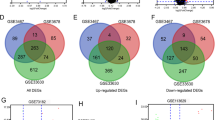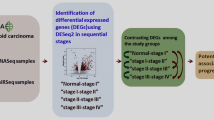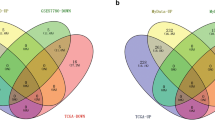Abstract
This study was aimed to identify the prognostic risk markers for thyroid papillary carcinoma (TPC) by bioinformatics. The clinical data of TPC and their microRNAs (miRNAs) and genes expression profile data were downloaded from The Cancer Genome Atlas. Elastic net-Cox’s proportional regression hazards model (EN-COX) was used to identify the prognostic associated factors. The receiver operating characteristic (ROC) curve and Kaplan-Meier (KM) curve were used to screen the significant prognostic risk miRNA and genes. Then, the target genes of the obtained miRNAs were predicted followed by function prediction. Finally, the significant risk genes were performed literature mining and function analysis. Total 1046 miRNAs and 20531 genes in 484 cases samples were identified after data preprocessing. From the EN-COX model, 30 prognostic risk factors were obtained. Based on the 30 risk factors, 3 miRNAs and 11 genes were identified from the ROC and KM curves. The target genes of miRNA-342 such as B-cell CLL/lymphoma 2 (BCL2) were mainly enriched in the biological process related to cellular metabolic process and Disease Ontology terms of lymphoma. The target genes of miRNA-93 were mainly enriched in the pathway of G1 phase. Among the 11 prognostic risk genes, v-maf avian musculoaponeurotic fibrosarcoma oncogene homologue F (MAFF), SRY (sex-determining region Y)-box 4 (SOX4), and retinoic acid receptor, alpha (RARA) encoded transcription factors. Besides, RARA was enriched in four pathways. These prognostic markers such as miRNA-93, miRNA-342, RARA, MAFF, SOX4, and BCL2 may be used as targets for TPC chemoprevention.

Similar content being viewed by others
References
Tabur S, Aksoy ŞN, Korkmaz H, Ozkaya M, Aksoy N, Akarsu E. Investigation of the role of 8-OHdG and oxidative stress in papillary thyroid carcinoma. Tumor Biol. 2014:1–8.
Mao LN, Wang P, Li ZY, Wang Y, Song ZY. Risk factor analysis for central nodal metastasis in papillary thyroid carcinoma. Oncol Lett. 2015;9(1):103–7.
Dinets A, Hulchiy M, Sofiadis A, Ghaderi M, Höög A, Larsson C, et al. Clinical, genetic, and immunohistochemical characterization of 70 Ukrainian adult cases with post-Chornobyl papillary thyroid carcinoma. Eur J Endocrinol. 2012;166(6):1049–60.
Shaha AR. Controversies in the management of thyroid nodule. Laryngoscope. 2000;110(2):183.
Yamashita H, Noguchi S, Murakami N, Kawamoto H, Watanabe S. Extracapsular invasion of lymph node metastasis is an indicator of distant metastasis and poor prognosis in patients with thyroid papillary carcinoma. Cancer. 1997;80(12):2268–72.
Cahill DP, Kinzler KW, Vogelstein B, Lengauer C. Genetic instability and Darwinian selection in tumours. Trends Cell Biol. 1999;9(12):M57–60.
Pollack JR, Sørlie T, Perou CM, Rees CA, Jeffrey SS, Lonning PE, et al. Microarray analysis reveals a major direct role of DNA copy number alteration in the transcriptional program of human breast tumors. Proc Natl Acad Sci. 2002;99(20):12963–8.
Huang Y, Prasad M, Lemon WJ, Hampel H, Wright FA, Kornacker K, et al. Gene expression in papillary thyroid carcinoma reveals highly consistent profiles. Proc Natl Acad Sci. 2001;98(26):15044–9.
Wreesmann VB, Sieczka EM, Socci ND, Hezel M, Belbin TJ, Childs G, et al. Genome-wide profiling of papillary thyroid cancer identifies MUC1 as an independent prognostic marker. Cancer Res. 2004;64(11):3780–9.
Handkiewicz-Junak D, Czarniecka A, Jarząb B. Molecular prognostic markers in papillary and follicular thyroid cancer: current status and future directions. Mol Cell Endocrinol. 2010;322(1):8–28.
Wagner GP, Kin K, Lynch VJ. Measurement of mRNA abundance using RNA-seq data: RPKM measure is inconsistent among samples. Theory Biosci. 2012;131(4):281–5.
Zou H, Hastie T. Regularization and variable selection via the elastic net. J R Stat Soc Ser B (Stat Methodol). 2005;67(2):301–20.
Friedman J, Hastie T, Tibshirani R. Regularization paths for generalized linear models via coordinate descent. J Stat Softw. 2010;33(1):1.
Robin X, Turck N, Hainard A, Tiberti N, Lisacek F, Sanchez J-C, et al. pROC: an open-source package for R and S+ to analyze and compare ROC curves. BMC Bioinforma. 2011;12(1):77.
Therneau T. A package for survival analysis in S. R package version 2.37-7. 2014.
Xiao F, Zuo Z, Cai G, Kang S, Gao X, Li T. miRecords: an integrated resource for microRNA-target interactions. Nucleic Acids Res. 2009;37 suppl 1:D105–10.
Dweep H, Sticht C, Pandey P, Gretz N. miRWalk–database: prediction of possible miRNA binding sites by “walking” the genes of three genomes. J Biomed Inform. 2011;44(5):839–47.
Shannon P, Markiel A, Ozier O, Baliga NS, Wang JT, Ramage D, et al. Cytoscape: a software environment for integrated models of biomolecular interaction networks. Genome Res. 2003;13(11):2498–504.
Kanehisa M, Goto S. KEGG: kyoto encyclopedia of genes and genomes. Nucleic Acids Res. 2000;28(1):27–30.
Croft D, O’Kelly G, Wu G, Haw R, Gillespie M, Matthews L et al. Reactome: a database of reactions, pathways and biological processes. Nucleic Acids Res. 2010:gkq1018.
Ashburner M, Ball CA, Blake JA, Botstein D, Butler H, Cherry JM, et al. Gene Ontology: tool for the unification of biology. Nat Genet. 2000;25(1):25–9.
Chen Y-A, Tripathi LP, Mizuguchi K. TargetMine, an integrated data warehouse for candidate gene prioritisation and target discovery. PLoS One. 2011;6(3):e17844.
Matys V, Fricke E, Geffers R, Gößling E, Haubrock M, Hehl R, et al. TRANSFAC®: transcriptional regulation, from patterns to profiles. Nucleic Acids Res. 2003;31(1):374–8.
Bovolenta LA, Acencio ML, Lemke N. HTRIdb: an open-access database for experimentally verified human transcriptional regulation interactions. BMC Genomics. 2012;13(1):405.
Cramer JD, Fu P, Harth KC, Margevicius S, Wilhelm SM. Analysis of the rising incidence of thyroid cancer using the Surveillance, Epidemiology and End Results national cancer data registry. Surgery. 2010;148(6):1147–53.
Shaha AR, Shah JP, Loree TR. Patterns of failure in differentiated carcinoma of the thyroid based on risk groups. Head Neck. 1998;20(1):26–30.
Vervoort S, van Boxtel R, Coffer P. The role of SRY-related HMG box transcription factor 4 (SOX4) in tumorigenesis and metastasis: friend or foe & quest. Oncogene. 2012;32(29):3397–409.
Pramoonjago P, Baras A, Moskaluk C. Knockdown of Sox4 expression by RNAi induces apoptosis in ACC3 cells. Oncogene. 2006;25(41):5626–39.
Tavazoie SF, Alarcón C, Oskarsson T, Padua D, Wang Q, Bos PD, et al. Endogenous human microRNAs that suppress breast cancer metastasis. Nature. 2008;451(7175):147–52.
Liu P, Ramachandran S, Seyed MA, Scharer CD, Laycock N, Dalton WB, et al. Sex-determining region Y box 4 is a transforming oncogene in human prostate cancer cells. Cancer Res. 2006;66(8):4011–9.
Aaboe M, Birkenkamp-Demtroder K, Wiuf C, Sørensen FB, Thykjaer T, Sauter G, et al. SOX4 expression in bladder carcinoma: clinical aspects and in vitro functional characterization. Cancer Res. 2006;66(7):3434–42.
Medina PP, Castillo SD, Blanco S, Sanz-Garcia M, Largo C, Alvarez S, et al. The SRY-HMG box gene, SOX4, is a target of gene amplification at chromosome 6p in lung cancer†. Hum Mol Genet. 2009;18(7):1343–52.
Singh B, Ronghe AM, Chatterjee A, Bhat NK, Bhat HK. MicroRNA-93 regulates NRF2 expression and is associated with breast carcinogenesis. Carcinogenesis. 2013;34(5):1165–72.
Pilotti S, Collini P, Rilke F, Cattoretti G, Del Bo R, Pierotti MA. Bcl2 protein expression in carcinomas originating from the follicular epithelium of the thyroid gland. J Pathol. 1994;172(4):337–42.
Tsujimoto Y, Gorham J, Cossman J, Jaffe E, Croce CM. The t (14; 18) chromosome translocations involved in B-cell neoplasms result from mistakes in VDJ joining. Science. 1985;229(4720):1390–3.
Lombardi L, Frigerio S, Collini P, Pilotti S. Immunocytochemical and immunoelectron microscopical analysis of BCL2 expression in thyroid oxyphilic tumors. Ultrastruct Pathol. 1997;21(1):33–9.
Grady W, Parkin R, Mitchell P, Lee J, Kim Y, Tsuchiya K, et al. Epigenetic silencing of the intronic microRNA hsa-miR-342 and its host gene EVL in colorectal cancer. Oncogene. 2008;27(27):3880–8.
Allegretto EA, McClurg MR, Lazarchik SB, Clemm DL, Kerner SA, Elgort MG, et al. Transactivation properties of retinoic acid and retinoid X receptors in mammalian cells and yeast. Correlation with hormone binding and effects of metabolism. J Biol Chem. 1993;268(35):26625–33.
Tang X-H, Gudas LJ. Retinoids, retinoic acid receptors, and cancer. Ann Rev Pathol: Mech Dis. 2011;6:345–64.
Lohnes D, Kastner P, Dierich A, Mark M, LeMeur M, Chambon P. Function of retinoic acid receptor γ in the mouse. Cell. 1993;73(4):643–58.
Lufkin T, Lohnes D, Mark M, Dierich A, Gorry P, Gaub M-P, et al. High postnatal lethality and testis degeneration in retinoic acid receptor alpha mutant mice. Proc Natl Acad Sci. 1993;90(15):7225–9.
Fitzgerald P, Teng M, Chandraratna RA, Heyman RA, Allegretto EA. Retinoic acid receptor α expression correlates with retinoid-induced growth inhibition of human breast cancer cells regardless of estrogen receptor status. Cancer Res. 1997;57(13):2642–50.
Haugen BR, Larson LL, Pugazhenthi U, Hays WR, Klopper JP, Kramer CA, et al. Retinoic acid and retinoid X receptors are differentially expressed in thyroid cancer and thyroid carcinoma cell lines and predict response to treatment with retinoids. J Clin Endocrinol Metab. 2004;89(1):272–80.
Roman SD, Ormandy CJ, Manning DL, Blamey RW, Nicholson RI, Sutherland RL, et al. Estradiol induction of retinoic acid receptors in human breast cancer cells. Cancer Res. 1993;53(24):5940–5.
Vasudevan N, Ogawa S, Pfaff D. Estrogen and thyroid hormone receptor interactions: physiological flexibility by molecular specificity. Physiol Rev. 2002;82(4):923–44.
Copland JA, Sheffield‐Moore M, Koldzic‐Zivanovic N, Gentry S, Lamprou G, Tzortzatou‐Stathopoulou F, et al. Sex steroid receptors in skeletal differentiation and epithelial neoplasia: is tissue-specific intervention possible? Bioessays. 2009;31(6):629–41.
Fan D, Liu SY, van Hasselt CA, Vlantis AC, Ng EK, Zhang H et al. Estrogen receptor alpha induces pro-survival autophagy in papillary thyroid cancer via stimulating reactive oxygen species and extracellular-signal-regulated kinases. J Clin Endocrinol Metab. 2015.
Crippa E, Lusa L, De Cecco L, Marchesi E, Calin GA, Radice P, et al. miR-342 regulates BRCA1 expression through modulation of ID4 in breast cancer. PLoS One. 2014;9(1):e87039.
Kolacinska A, Morawiec J, Pawlowska Z, Szemraj J, Szymanska B, Malachowska B, et al. Association of microRNA-93, 190, 200b and receptor status in core biopsies from stage III breast cancer patients. DNA Cell Biol. 2014;33(9):624–9.
Zeng Q, Chen G, Vlantis A, Van Hasselt C. Oestrogen mediates the growth of human thyroid carcinoma cells via an oestrogen receptor–ERK pathway. Cell Prolif. 2007;40(6):921–35.
Kimura T, Tanizawa O, Mori K, Brownstein MJ, Okayama H. Structure and expression of a human oxytocin receptor. 1992.
Kimura T, Takemura M, Nomura S, Nobunaga T, Kubota Y, Inoue T, et al. Expression of oxytocin receptor in human pregnant myometrium. Endocrinology. 1996;137(2):780–5.
Cassoni P, Marrocco T, Deaglio S, Sapino A, Bussolati G. Biological relevance of oxytocin and oxytocin receptors in cancer cells and primary tumors. Ann Oncol. 2001;12 suppl 2:S37–9.
Cassoni P, Sapino A, Negro F, Bussolati G. Oxytocin inhibits proliferation of human breast cancer cell lines. Virchows Arch. 1994;425(5):467–72.
Zhong M, Clarke S, Vo BT, Khan SA. The essential role of Giα2 in prostate cancer cell migration. Mol Cancer Res. 2012;10(10):1380–8.
Zhang J, Wang Y, Zhen P, Luo X, Zhang C, Zhou L, et al. Genome-wide analysis of miRNA signature differentially expressed in doxorubicin-resistant and parental human hepatocellular carcinoma cell lines. PLoS One. 2013;8(1):e54111.
Conflicts of interest
None.
Author information
Authors and Affiliations
Corresponding author
Additional information
Highlights
1. SOX4 was both a prognostic risk gene and a target gene of miRNA-93.
2. BCL2, a target gene of miRNA-342, was enriched in the DO terms of lymphoma.
3. RARA and MAFF were identified to be prognostic risk genes in our study.
Rights and permissions
About this article
Cite this article
Min, XS., Huang, P., Liu, X. et al. Bioinformatics analyses of significant prognostic risk markers for thyroid papillary carcinoma. Tumor Biol. 36, 7457–7463 (2015). https://doi.org/10.1007/s13277-015-3410-6
Received:
Accepted:
Published:
Issue Date:
DOI: https://doi.org/10.1007/s13277-015-3410-6




